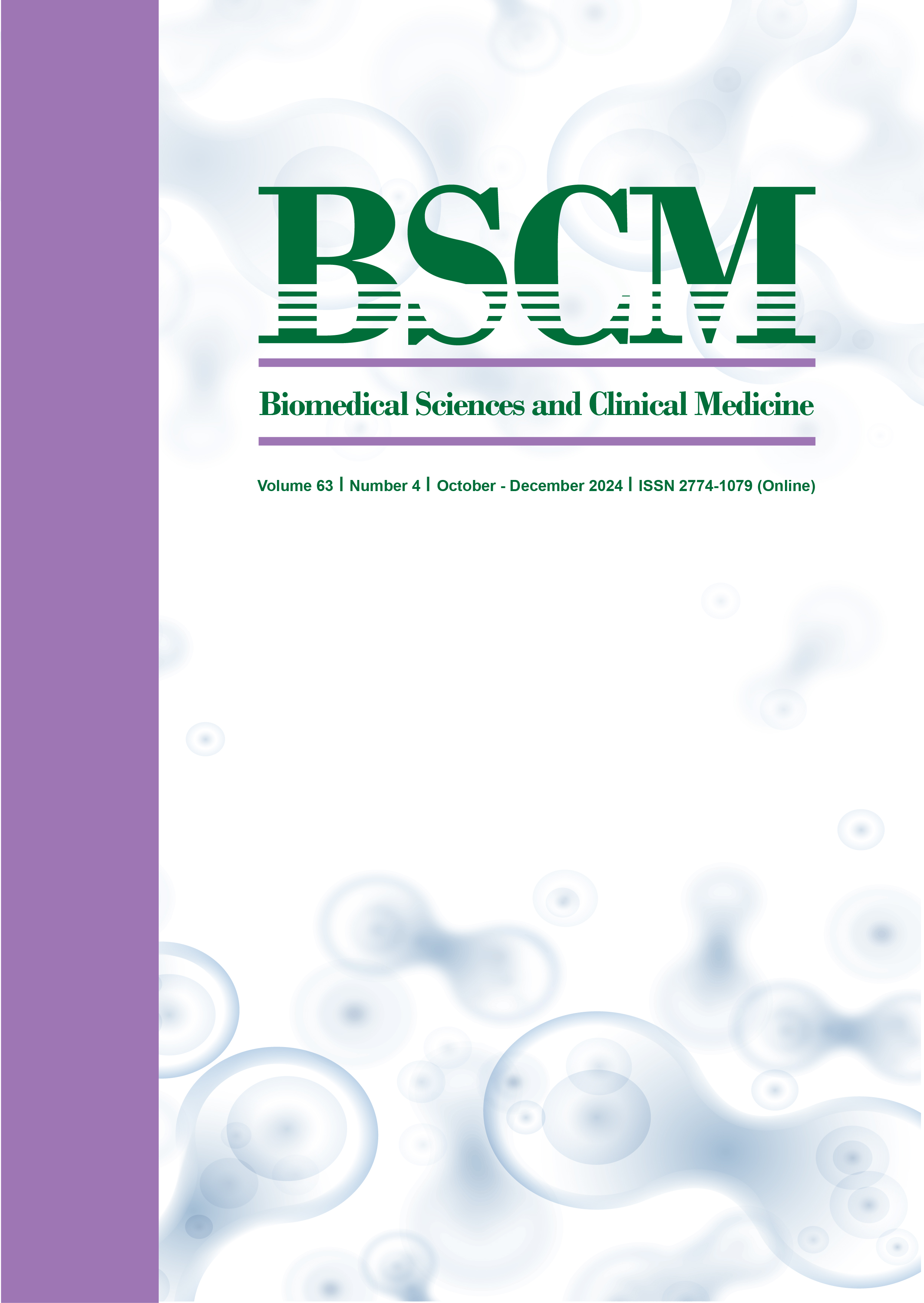Visual Outcomes Following Surgical Treatment of Pituitary Adenomas: Functional Versus Non-Functional
Main Article Content
Abstract
Objective This study aims to compare visual outcomes following surgical resection of functional and non-functional pituitary adenoma.
Methods A retrospective observational study included 103 patients with pituitary adenoma who underwent tumor resection at Chiang Mai university hospital between January 2010 and December 2019. Basic characteristics, tumor specific data, hormonal status and neuro-ophthalmic data were collected and statistically analyzed to identify differences in visual outcomes between functional and non-functional tumors.
Results Between the 51 (49.50%) functional pituitary adenoma and 52 (50.50%) non-functional pituitary adenoma patients in this study, there were no differences in mean age at initial visit, sex, duration of onset, type of surgery, or adjunct radiotherapy. Initial visual acuity in logMAR in both the better and the worse eye, as well as the initial visual impairment
score (VIS) which represents a combination of visual acuity and visual field, showed no statistically significant differences. The final visual acuity of the better eye was significantly better in the functional group (0.08± 0.15) than in the non-functional group (0.22±0.47), with a p-value of 0.04. Similarly, the VIS score was significantly better in the functional group (18.37±19.85) than in the non-functional group (28.87±26.83), with a p-value of 0.028.
Conclusions Patients with functional pituitary adenomas have potentially better visual outcomes than those with non-functional pituitary adenomas after surgical resection.
Article Details

This work is licensed under a Creative Commons Attribution 4.0 International License.
References
Asa SL, Ezzat S. The pathogenesis of pituitary tumours. Nat Rev Cancer. 2002;2:836-49.
Qin J, Li K, Wang X, Bao Y. A comparative study of functioning and non-functioning pituitary adenomas. Medicine (Baltimore). 2021;100:e25306. PubMed PMID: 33832102
Mete O, Cintosun A, Pressman I, Asa S. Epidemiology and biomarker profile of pituitary adenohypophysial tumors. Mod Pathol. 2018;31:900-9.
Daly A, Rixhon M, Adam C, Dempegioti A, Tichomirowa MA, Beckers A. High prevalence of pituitary adenomas: a cross-sectional study in the province of Liege, Belgium. J Clin Endocrinol Metab. 2006;91:4769-75.
Fernandez A, Karavitaki N, Wass J. Prevalence of pituitary adenomas: a community-based, cross-sectional study in Banbury (Oxfordshire, UK). Clin Endocrinol (Oxf). 2010;72:377-82.
Tjörnstrand A, Gunnarsson K, Evert M, Holmberg E, Ragnarsson O, Rosén T, et al. The incidence rate of pituitary adenomas in western Sweden for the period 2001-2011. Eur J Endocrinol. 2014;171:519-26.
Agustsson T, Baldvinsdottir T, Jonasson J, Olafsdottir E, Steinthorsdottir V, Sigurdsson G, et al. The epidemiology of pituitary adenomas in Iceland, 1955-2012: a nationwide population-based study. Eur J Endocrinol. 2015;173:655-64.
Raappana A, Koivukangas J, Ebeling T, Pirilä T. Incidence of pituitary adenomas in Northern Finland in 1992-2007. J Clin Endocrinol Metab. 2010;95:4268-75.
Uy B, Wilson B, Kim WJ, Prashant G, Bergsneider M. Visual outcomes after pituitary surgery. Neurosurg Clin N Am. 2019;30:483-9.
Thammakumpee K, Buddawong J, Vanikieti K, Jindahra P, Padungkiatsagul T. Preoperative peripapillary retinal nerve fiber layer thickness as the prognostic factor of postoperative visual functions after endoscopic transsphenoidal surgery for pituitary adenoma. Clin Ophthalmol. 2022;16:4191-8.
Muskens I, Zamanipoor Najafabadi A, Briceno V, Lamba N, Senders J, van Furth WR, et al. Visual outcomes after endoscopic endonasal pituitary adenoma resection: a systematic review and meta-analysis. Pituitary. 2017;20:539-52.
Cohen A, Cooper P, Kupersmith M, Flamm E, Ransohoff J. Visual recovery after transsphenoidal removal of pituitary adenomas. Neurosurgery. 1985;17:446-52.
Ho RW, Huang HM, Ho JT. The influence of pituitary adenoma size on vision and visual outcomes after trans-sphenoidal adenectomy: a report of 78 cases. J Korean Neurosurg Soc. 2015;57:23-31.
Luomaranta T, Raappana A, Saarela V, Liinamaa MJ. Factors affecting the visual outcome of pituitary adenoma patients treated with endoscopic transsphenoidal surgery. World Neurosurg. 2017;105:422-31.
Fahlbusch R, Schott W. Pterional surgery of meningiomas of the tuberculum sellae and planum sphenoidale: surgical results with special consideration of ophthalmological and endocrinological outcomes. J Neurosurg. 2002;96:235-43.
Ogra S, Nichols A, Stylli S, Kaye A, Savino P, Danesh- Meyer H. Visual acuity and pattern of visual field loss at presentation in pituitary adenoma. J Clin Neurosci. 2014;21:735-40.
Wang H, Sun W, Fu Z, Si Z, Zhu Y, Zhai G, et al. The pattern of visual impairment in patients with pituitary adenoma. J Int Med Res. 2008;36:1064-9.
Butenschoen VM, Schwendinger N, von Werder A, Bette S, Wienke M, Meyer B, et al. Visual acuity and its postoperative outcome after transsphenoidal adenoma resection. Neurosurg Rev. 2021;44:2245-51.
Tritos NA, Miller KK. Diagnosis and Management of Pituitary Adenomas: A Review. JAMA. 2023;329:1386-98.
Rivoal O, Brézin AP, Feldman-Billard S, Luton JP. Goldmann perimetry in acromegaly: a survey of 307 cases from 1951 through 1996. Ophthalmology. 2000; 107:991-7.
Batista R, Trarbach E, Marques M, Cescato V, da Silva G, Herkenhoff C, et al. Nonfunctioning pituitary adenoma recurrence and its relationship with sex, size, and hormonal immunohistochemical profile. World Neurosurg. 2018;120:e241-e6. Pubmed PMID: 30138730
Ferrante E, Ferraroni M, Castrignanò T, Menicatti L, Anagni M, Reimondo G, et al. Non-functioning pituitary adenoma database: a useful resource to improve the clinical management of pituitary tumors. Eur J Endocrinol. 2006;155:823-9.
Chen Y, Chuan H, Yu S, Li C, Wu Z, Li G, et al. A novel invasive-related biomarker in three subtypes of nonfunctioning pituitary adenomas. World Neurosurg. 2017;100:514-21.
Lao Y, Gao H, Zhong Y. Vascular architecture of the human optic chiasma and bitemporal hemianopia. Chin Med Sci J. 1994;9:38-44.
Yu F, Chen L, Su Y, Huo L, Lin X, Liao R. Factors influencing improvement of visual field after trans-sphenoidal resection of pituitary macroadenomas: a retrospective cohort study. Int J Ophthalmol. 2015;8: 1224-8.
Fedele M. Pituitary Tumors: New Insights into Molecular Features, Diagnosis and Therapeutic Targeting. Cancers (Basel). 2021;13:1697. Pubmed PMID: 33916675


